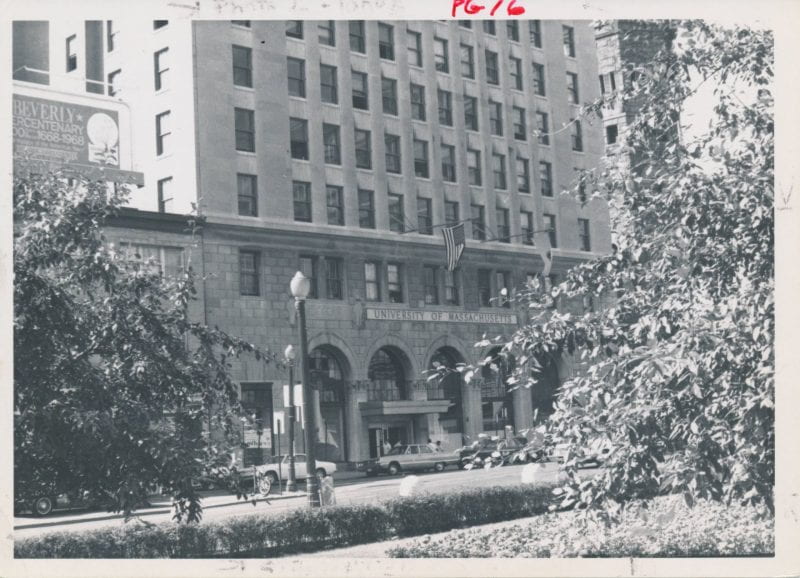
“Students performing a play.” Here we can see some of the Boston Normal School students putting on a play. I am unsure as to where this play took place, but given the photograph’s estimated time frame, it was probably at the Rice Building, the home to the Normal School from 1876-1907 (Flynn 1980, XVI).
Author: Kayla Allen, Archives Assistant and graduate student in the History MA Program at UMass Boston

“Primary school students in Appleton Street School within the Rice Building.” This is one of my favorite photographs from the collection. Here are young children in the model classroom at the Rice Building. Normal School students would get practical experience by teaching these little ones and working with master teachers. There were some beautiful classrooms in the Rice Building!
In the nineteenth century, the education of young children was changing. The standards a teacher had to meet before getting their own classroom were improving and more and more young women were encouraged to obtain an education beyond elementary school. One school that followed these educational trends over a century was the Boston Normal School (BNS). The City of Boston formed the Normal School to train girls to become teachers in the Boston Public School (BPS) system. The school grew and morphed and changed, eventually becoming the Teachers College of the City of Boston, then a state college, then Boston State College, and was then absorbed into the University of Massachusetts Boston.
The time frame for the University Archives and Special Collection’s Normal School digital photograph collection is from 1872 to 1922. This is the period after the Normal School separated from Girls’ High, its original partner, and became its own institution solely focused on the training of teachers. The school moved from a shared building with Girls’ High to the Rice Building on Dartmouth and Appleton Streets, and a couple of decades later, moved to its final space at 625 Huntington Avenue. At both of the newer locations, the school developed model schools with children from the community, staffed by some of the best teachers in the state who became mentors to the Normal School students (Flynn 1980, 47).

“Boston Normal School exterior.” This is the Boston Normal School as it stood at 625 Huntington Avenue. To its left (our right) is the gymnasium that they shared with the Girls’ Latin School. Girls’ Latin had a similar building to the Normal School on the other side of the gymnasium. Behind the gymnasium was a courtyard, and behind the courtyard was the Patrick A. Collins Building, which also connected the Normal School and Girls’ Latin (Flynn, 37). Essentially, the buildings altogether made up one large square.
During this span of fifty years, the Normal School training program moved from two years long to three years long, and when students graduated, they did not get a degree but instead received certification that they could teach in the BPS system. The standards for teacher training changed greatly over the years of the Normal School, and at some points, the curriculum was different each year. Following the history of this school is similar to following the history of teacher training throughout the United States. One thing that made our Normal School particularly special is that up until 1931, Boston students did not have to pay to attend and students from outside the city had to pay very little (Flynn, 3). The City of Boston wanted any young woman interested in becoming a teacher in their schools to be able to do so, regardless of socioeconomic status.
Eventually, in 1922, following the trend of normal schools across the country, Boston Normal School became a teachers college and developed a curriculum that would allow students to get a bachelor’s degree in education in four years and a master’s in five. At this point, BNS had been allowing male students for a little over a decade. Clearly, times were changing, and the standards for teacher training were starting to settle into the ones we have today.
Be sure to check out the Normal School digital photograph collection and the finding aid for its home, the Boston State College collection. There are some gems waiting to be discovered!

“Boston Normal School Class of 1919.” This photograph shows the students of the 1919 Boston Normal School graduating class with a man I believe to be Wallace C. Boyden, their headmaster. It is a particularly striking image; the girls’ faces look as if they’re floating in a sea of white. With the brick and marble facade of the building, it’s probable that this photo was taken on the Normal School campus at 625 Huntington Avenue.
The most invaluable source of information for this blog post was the 1980 History of Boston Normal School – Teachers College, 1852-1952 by Elizabeth D. Flynn, which we have in our digital collections. Flynn was once herself a student of Boston Normal School and created this text as an effort to preserve the school’s story. If you are at all interested in the history of teacher training in the United States or the Normal School itself, Flynn’s work is a fascinating read.
The quote in the title of this blog post is taken from the article “How Vivid the Memories,” by Lillian Towne, Normal School class of 1885, in the Centennial issue of The Torch, a Normal School publication. Her article is quoted in Elizabeth Flynn’s book on page twenty-seven.
All images shared here are courtesy of the University Archives and Special Collections Department, Joseph P. Healey Library, University of Massachusetts Boston: Boston State College collection.



























